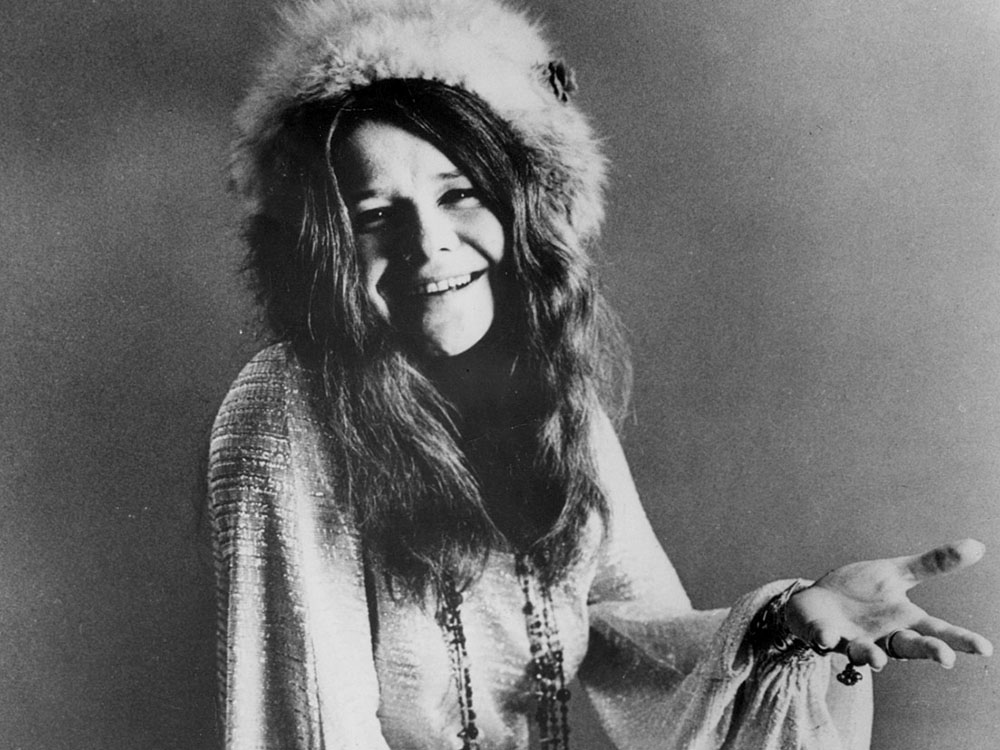
A 1970 publicity photo of Janis Joplin (Wikimedia Commons/Albert B. Grossman Management)
1. I'm working hard not to make this an album about her death. (But isn't this an album about her death? Wouldn't you want a way of understanding it?) Maybe a list of what she needed to say before she was able to die? Or a love letter to the fact of her living,
2. which was fast. Janis said that she'd rather have 10 years of fast living than a lifetime of mundanity.
3. Born: Jan. 19, 1943. Port Arthur, Texas.
4. You need to steel yourself in order to listen to Janis Joplin sing.
5. "Pearl," Janis' best and last album, was released posthumously in January 1971. That's three months after she died at the age of 27.
6. With four years of making music, from 1966 through 1970, she got her speed. There are 10 tracks on the album; two are incomplete. Track five, "Buried Alive in the Blues," was waiting for Janis' vocals — set to be recorded on the day that she passed — and the producers decided to leave the song as is, without her voice.
7. When someone leaves early, we wonder what they would have made had they had more time. We wonder who would have made that kind of art, had they not existed at all. What I'm left with: Is this what a world without Janis Joplin looks like? (Is this what a ghost sounds like?)
8. A ghost sounds like track eight, "Mercedes Benz." "A song of great social and political import," Janis announces before she sings, her Texas twang elongating the "e" in Benz, never far from revealing a certain truth: that she was really just a Texan expat living in San Francisco. She sings a cappella, unbuoyed by her band, not praising God but challenging him, to make a better life for her, to buy her a color TV, to buy her a luxury car. Her voice stretches around the word "lord" like someone who does not pray often. Like someone who fears the unknowable magic of prayer. For the final recitation of the chorus, she sings out "everybody!" but no one joins her. Instead, it's just her, and her voice. Janis, as she always was.
9. On tour, Janis was alone for an amount of time that must feel normal to those who do what she did, and odd to those of us who only ever associate her with teeming crowds of people, of souls, of hands, who want a little bit of that magic she made on stage. Alone, of course, has a sound. Alone sounds like silence.
10. When asked on "The Dick Cavett Show" why there aren't "more ladies who do what you do?" Janis responded, "It's not feminine ... to get on the bottom side of the music."
11. I suppose there's some world underneath the music, where the writers and composers spin their emotions into a thread. To sew themselves up. Or see what happens when you pull the stitches out. Searching for some otherside, where did Janis find herself otherside-ing? Where was she trying to go? And who did she want to be when she got there? I think that Janis was always trying to get to the end of the song, just so that she could start another. As she sings, it almost sounds like she's injuring herself in order to get the words out; music, a release only because it was less painful than the pain of life itself.
Advertisement
12. Janis told Cavett that the stage was "the best thing that ever happened to me." Performance, something that happened to her. Affected by music, she almost seems possessed, by something other than herself. I have never been affected by anything that deeply. Or felt so safe in that affectation so as to allow myself to look uncontrolled, disturbed, away from myself. (How much do you allow yourself to be affected?) Janis scares me. In feeling deeply, she reminds me that I'm working all the time at the practice of being unfeeling. She is deeply alive. I worry I might not be at all. Most of the time I am hiding.
13. "Pearl" is the name that Janis would have given herself, had she birthed and named herself; though you could say, through her music, Janis was reborn with every song. Peggy Caserta, Janis' girlfriend or friend depending on who you ask, said, "I never liked the name Peggy, and wanted to be more floozy, you know? Somewhere along the line, Janis started talking about changing her name to Pearl."
14. A lot of women change their names — like their last as an ode to marriage. Fewer change their first names. Multiple women in my family changed their first names (two of my aunts come to mind) to leave a part of their lives behind. I amended my first and last in 2019, and was told by the social security agent adjusting my files, congratulations. "For what?" I asked the agent. "On getting married," he replied. "I'm not married," I said. I had only wanted to become more myself.
15. To become herself, Janis made "Pearl."





